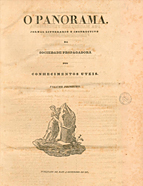

................................
While O Panorama was read abroad, its pages also included content from outside Portugal. The newspaper frequently featured articles about foreign cities—mainly in Europe—often from a historical perspective, as well as descriptions of famous monuments (e.g., the "Great Wall of China," Issue 53, p. 417, 1853). It also reported on current events, such as the "Current State of Greece" (Issue 13, p. 101, 1837), and regularly included articles—frequently illustrated—on the flora and fauna of other continents. This made O Panorama an excellent vehicle for exploring and understanding other contexts.
The newspaper continued uninterrupted until 1839, when Alexandre Herculano published his final issue as chief editor and bid farewell in a short note (Issue 115, p. 221, 1839). He left to assume the position of Director of the Royal Libraries of Ajuda and Necessidades, following his appointment by King Fernando. This marked the end of Herculano’s time at the newspaper. Interestingly, it was António Feliciano de Castilho who succeeded Herculano, serving as editor until 1841. Castilho then departed to oversee another periodical, the Revista Universal Lisbonense [Universal Magazine of Lisbon], which he directed from 1841 to 1845. After Castilho, the second series of O Panorama was led by António de Oliveira Marreca until 1843. In 1844, the editions of O Panorama associated with the Sociedade Propagadora dos Conhecimentos Úteis came to an end, primarily due to a decline in subscription payments, which may have undermined the Society's financial stability. Non-payment of subscriptions was frequently mentioned in the newspaper's pages.
Despite its closure, O Panorama had already made a significant cultural impact. The various volumes formed a valuable collection of content worthy of detailed study. As outlined earlier, the newspaper's pages included contributions from a wide range of fields. Between 1837 and 1844, the most prominently featured themes were History (which stood out), Geography, and Literature. Secondary themes included technical knowledge, agriculture, useful advice, and, unsurprisingly, anecdotes. For a comprehensive description of all the topics covered, see A. M. Ribeiro’s Periodismo cientifico e literário Romântico : O Panorama [Romantic Scientific and Literary Journalism: Panorama], pp. 69-72). These trends continued into subsequent series.
This work is financed by national funds through FCT - Foundation for Science and Technology, I.P, in the scope of the projects UIDB/04311/2020 and UIDP/04311/2020.
